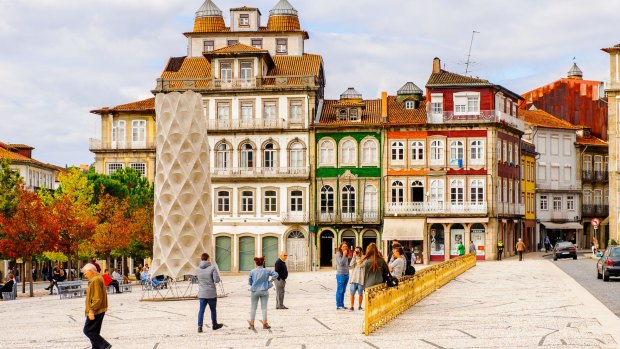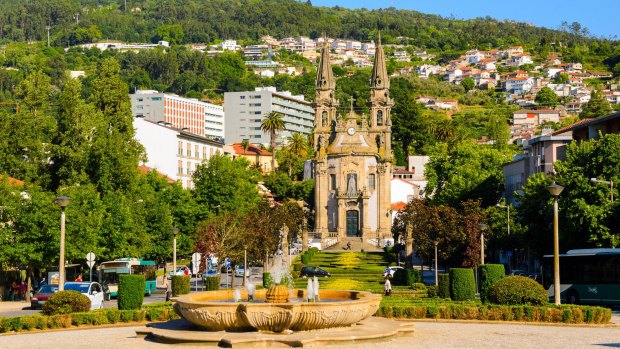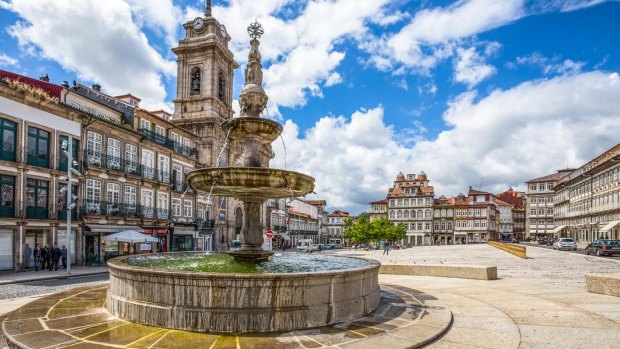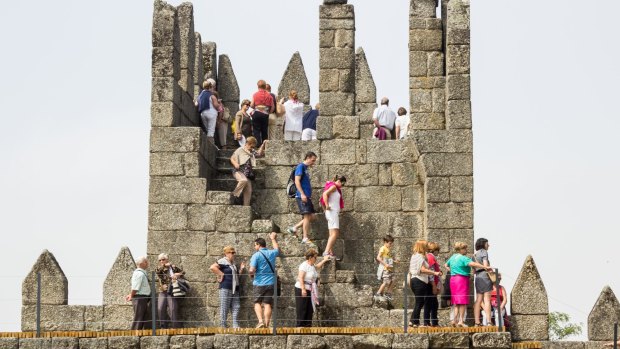This was published 6 years ago
Guimaraes, Portugal's medieval capital: The easy-going town that seduced a king
By Mark Chipperfield

Toural Square in the historic centre of Guimaraes, Portugal.Credit: Shutterstock
"Once we were so great, now we are so small". This commonly used phrase sums up Portugal's decline from 15th-century maritime superpower to a minor European country under the dictator Antonio de Oliveira Salazar.
While the Portuguese are certainly not alone in their nostalgia for past glories, few other nationalities have such a long, illustrious and colourful history to excavate.
Although Portugal is one of the oldest civilisations in Europe – cave drawings in the Coa Valley date back to 25,000BC – this part of the Iberian Peninsula faced a tortuous path to independence, repelling the Romans, the Vandals Suevi, Visigoths and finally the Moors.

Guimaraes was Portugal's medieval capital. Credit: Alamy
After 300 years of Islamic rule the invaders were finally routed at the Battle of Ourique in 1139, Afonso Henriques was elevated to the title of king of Portugal and the state's capital was established in the northern city of Guimaraes.
It is hardly surprising that this picturesque medieval town holds such a special place in local affections. Not only was Guimaraes the birthplace of the first king, it was from here that Afonso launched the Reconquista which drove the Moors from Portuguese soil in 1249.
"Guimaraes is very important for all Portuguese people," says my guide Iolanda Rodrigues. "Although the capital was soon moved to Coimbra and finally Lisbon, Guimaraes is the birthplace of our nation and remains special."

A fountain in Toural Square, in the city centre of Guimaraes.Credit: Alamy
A popular day trip for anyone cruising on the Douro River, Guimaraes is also easily accessible by train from Porto. Visitors can happily wile away a few hours exploring the old city, which is packed with architectural gems, such as Guimaraes Castle, the grand City Hall and the Igreja de Nossa Senhora da Oliveira, a beautiful convent church designed by the master builder Garcia de Toledo – the name of the church is tied up with legend concerning a Visigoth king called Wamba ("big belly") and an olive tree.
"Wamba said he would only rule this territory if a dead olive branch would bud," explains Iolanda. "So he thrust his olive branch into the ground and guess what happened? The branch sprang to life and we have this lovely church – the fine tower is a later addition."
The nearby square, Largo da Oliveira, is a delightful place for a relaxing lunch or a chilled glass of Vinho Verde, the fresh, slightly bubbly white wine grown in the Minho region. Despite its name, the wine is not green but honey coloured and offers a citrusy flavour and a clean finish.

Tourists visit the medieval Castle of Guimaraes.Credit: Shutterstock
With its tangle of cobbled laneways, august squares and well-preserved townhouses the old city, which was declared a UNESCO World Heritage Site in 2001, is a delight to explore by foot, but make sure you set aside an hour or so to tour the Palace of the Dukes of Braganza.
Built on the grand scale by Don Afonso, the Duke of Braganza, the palace, which dates from 1420, was clearly an attempt to rival the royal houses of France, Holland and Germany. Features such as its steep roofline and numerous high chimneys are distinctly un-Portuguese.
Of particular interest are the massive Pastrana Tapestries which narrate some of the Portuguese conquests in Africa – sadly, these are copies, the original tapestries, like much of the original furnishings, were dispersed when the Ducal Palace was abandoned in the 16th century. After many years of neglect, restoration finally began in 1937; today the palace houses a well-stocked museum and several exhibition spaces, while the second-floor apartments are used for presidential visits.
"Salazar took a great interest in the restoration of the palace and often stayed here," says Iolanda. "Much of the redesign of the state rooms occurred during that time."
It's a surprising revelation. The prime minister, who ruled Portugal from 1932 to 1968, was known for his simple tastes and modest lifestyle and yet even Salazar was seduced by this easy-going town, with its cobbled squares, gothic churches and miraculous olive tree.
TRIP NOTES
MORE
traveller.com.au/portugal
FLY
Etihad Airways flies frequently from Melbourne, Sydney, Perth and Brisbane to Switzerland, with onward connections to Porto aboard local carrier TAP. Cruises depart from downtown Porto, 11 kilometres south of the airport. www.etihad.com
CRUISE
Scenic's 11-day Unforgettable Douro cruise sails from Porto along the Douro River to Vega de Terron on the Spanish border and includes a day-trip to Salamanca. Guests can choose from a wide range of shore experiences, such as guided city tours, signature dining events, wine tastings and canoeing expeditions. Prices start at $6295 a person, twin share, for a standard suite. Tariffs include all meals and drinks on board, shore excursions, complimentary mini-bar, free Wi-Fi, butler service, airport transfers and all tips and gratuities. For bookings phone 1300 742 859 or visit www.scenic.com.au.
Mark Chipperfield was a guest of Scenic and Etihad Airways.
Sign up for the Traveller Deals newsletter
Get exclusive travel deals delivered straight to your inbox. Sign up now.